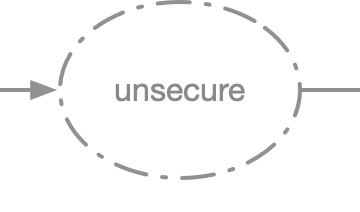In this post we provide the definition of finite groups and we show a few examples meaningful for cryptography and blockchain
Def. Finite Groups
Def. A group ![]() is a set
is a set ![]() together with an operation
together with an operation ![]() combining two elements of
combining two elements of ![]() , which satisfies the following properties:
, which satisfies the following properties:
- Closeness: The group operation
 is closed:
is closed: 
- Associativity:
 ,
, 
- Identity: there is a neutral element
 s.t.
s.t.  ,
, 
- Inverse:
 , there is an inverse element
, there is an inverse element  s.t.
s.t. 
Def. A subgroup ![]() of a group
of a group ![]() is any
is any ![]() s.t.
s.t. ![]() is also a group w.r.t. the
is also a group w.r.t. the ![]() operation.
operation.
Def. A group ![]() is called Abelian, or commutative, if satisfies the property
is called Abelian, or commutative, if satisfies the property
- Commutativity:
 ,
, 
Examples
- 2.
 and
and  are abelian groups: they have identity 0; any element
are abelian groups: they have identity 0; any element  has an inverse
has an inverse  , they satisfy associativity, and they satisfy commutativity.
, they satisfy associativity, and they satisfy commutativity.  is not a group: the element
is not a group: the element  has no inverse, and there is nothing we can multiply
has no inverse, and there is nothing we can multiply  to get
to get 
 is not a group: there is no integer we can multiply
is not a group: there is no integer we can multiply  by to get to
by to get to  .
. the set of integers
the set of integers  together with the operation
together with the operation  , is not a group: the elements
, is not a group: the elements  don’t have an inverse operation
don’t have an inverse operation the set of integers
the set of integers  (
( excluding those which does not have inverse), together with the operation
excluding those which does not have inverse), together with the operation  , is a multiplicative group.
, is a multiplicative group.
Multiplicative Groups of Integers Modulo p (Diffie-Hellman)
The Diffie-Hellman key exchange algorithm is based on the multiplicative group of integers modulo a prime number ![]() , denoted by
, denoted by ![]() . In this context, the group consists of the integers
. In this context, the group consists of the integers ![]() under multiplication modulo
under multiplication modulo ![]() .
.
Example
- Consider
 , which forms a cyclic group under multiplication modulo 7. This is the basis for the Diffie-Hellman protocol, used for secure key exchange in cryptographic systems, including some blockchain implementations.
, which forms a cyclic group under multiplication modulo 7. This is the basis for the Diffie-Hellman protocol, used for secure key exchange in cryptographic systems, including some blockchain implementations.
Additive Group of Integers Modulo p (Blockchain Consensus Mechanisms)
In blockchain systems, cryptographic hash functions often map inputs to an additive group modulo ![]() . This property is used to ensure security and immutability of the blockchain ledger. Cryptographic schemes like RSA also rely on the structure of groups of integers under modulo operations.
. This property is used to ensure security and immutability of the blockchain ledger. Cryptographic schemes like RSA also rely on the structure of groups of integers under modulo operations.
Example
- In Bitcoin, the operation of adding transactions into a block involves checking cryptographic hashes that are element of an additive group modulp
 . This ensures that altering the transaction history is computationally infeasible
. This ensures that altering the transaction history is computationally infeasible
Elliptic Curve Cryptography (ECC)
In cryptography, elliptic curves over finite fields form Abelian groups, and they are widely used due to their efficiency and security at smaller key sizes compared to RSA. An elliptic curve group ![]() , where
, where ![]() is a finite field of prime order
is a finite field of prime order ![]() , can be used for key exchange, like in the Elliptic Curve Diffie-Hellmann (ECDH), abd digital signatures, like ECDSA
, can be used for key exchange, like in the Elliptic Curve Diffie-Hellmann (ECDH), abd digital signatures, like ECDSA



0 Comments